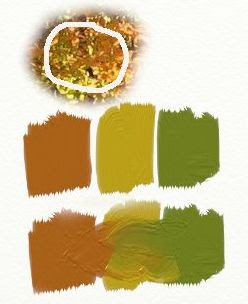To modulate is to make a gradual change within whatever is being modulated. In music, a single chord can modulate to another key just by passing through a chord both keys have in common. In painting, one way we can modulate color is to use this same principle--move from one color to another THROUGH a hue each has in common.
Within this image of a fall tree, we can see greens reflecting onto the orange leaves.
One way to modulate this in paint is to use the hue both green and orange have in common: yellow. We'll take our color from the small sample I have circled.
In the example above, I've modulated in a high intensity. If we change the intensity, the modulation looks more realistic for the shadowed areas.
But the one thing we've not yet mentioned is VALUE. For modulation of hues and intensities to be successful, it works better for colors being modulated to be in the same value range. Give it a try.
| P. S. This principle of modulating with a hue both colors have in common is perfect for any two colors that are not both primary colors. If you want to modulate two primary colors, simply mix one into the other at the SAME value and intensity. You'll be modulating through their secondary hue. |
NEWS AND UPDATES!
Our August Series of Video Tutorials
If you feel like you're in a wrestling match when working with color, this new series of video tutorials might be just what you are looking for. I've focused the series on two of our most difficult colors with which artists work: greens and yellows. This week's lesson Tacking Greens hones in on how to modulate greens by varying their intensity and hue within local value areas.
What You Can Expect When You Become My Student
When we're filming the video tutorials, I have you in mind. I have learned to think of the camera as my classroom filled with students eager to learn the concepts with which I'm working while giving that particular lesson. Those decades of teaching college and in my own art school prepared me for this.
When you purchase a video lesson, you become my student, but you become a member of a virtual classroom as well. We have set up the Forum on Facebook for you to interact with others as well as get reinforcement from me. Today's technology allows me to talk directly to you via video on Facebook, a free service included when you purchase any video lesson, whether download or DVD.





No comments:
Post a Comment